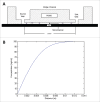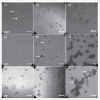In vitro formation of neuroclusters in microfluidic devices and cell migration as a function of stromal-derived growth factor 1 gradients
- PMID: 26744909
- PMCID: PMC5308225
- DOI: 10.1080/19336918.2015.1131388
In vitro formation of neuroclusters in microfluidic devices and cell migration as a function of stromal-derived growth factor 1 gradients
Abstract
Central nervous system (CNS) cells cultured in vitro as neuroclusters are useful models of tissue regeneration and disease progression. However, the role of cluster formation and collective migration of these neuroclusters to external stimuli has been largely unstudied in vitro. Here, 3 distinct CNS cell types, medulloblastoma (MB), medulloblastoma-derived glial progenitor cells (MGPC), and retinal progenitor cells (RPC), were examined with respect to cluster formation and migration in response to Stromal-Derived Growth Factor (SDF-1). A microfluidic platform was used to distinguish collective migration of neuroclusters from that of individual cells in response to controlled concentration profiles of SDF-1. Cell lines were also compared with respect to expression of CXCR4, the receptor for SDF-1, and the gap junction protein Connexin 43 (Cx43). All cell types spontaneously formed clusters and expressed both CXCR4 and Cx43. RPC clusters exhibited collective chemotactic migration (i.e. movement as clusters) along SDF-1 concentration gradients. MGPCs clusters did not exhibit adhesion-based migration, and migration of MB clusters was inconsistent. This study demonstrates how controlled microenvironments can be used to examine the formation and collective migration of CNS-derived neuroclusters in varied cell populations.
Keywords: SDF-1; central nervous system; chemotaxis; collective migration; medulloblastoma; retinal progenitors; stromal-derived growth factor.
Figures








Similar articles
-
The chemokine stromal cell-derived factor-1 regulates the migration of sensory neuron progenitors.J Neurosci. 2005 Apr 20;25(16):3995-4003. doi: 10.1523/JNEUROSCI.4631-04.2005. J Neurosci. 2005. PMID: 15843601 Free PMC article.
-
CCR3- and CXCR4-mediated interactions regulate migration of CD34+ human bone marrow progenitors to ischemic myocardium and subsequent tissue repair.J Thorac Cardiovasc Surg. 2008 Oct;136(4):1044-53. doi: 10.1016/j.jtcvs.2007.12.067. Epub 2008 Jul 7. J Thorac Cardiovasc Surg. 2008. PMID: 18954648
-
[Effects of SDF-1/CXCR4 on the chemotaxis of cord blood AC133(+) cells].Zhongguo Shi Yan Xue Ye Xue Za Zhi. 2009 Apr;17(2):408-11. Zhongguo Shi Yan Xue Ye Xue Za Zhi. 2009. PMID: 19379577 Chinese.
-
Role of the alpha-chemokine stromal cell-derived factor (SDF-1) in the developing and mature central nervous system.Glia. 2003 Apr 15;42(2):139-48. doi: 10.1002/glia.10139. Glia. 2003. PMID: 12655598 Review.
-
Stromal-derived factor 1 signalling regulates radial and tangential migration in the developing cerebral cortex.Dev Neurosci. 2008;30(1-3):117-31. doi: 10.1159/000109857. Dev Neurosci. 2008. PMID: 18075260
Cited by
-
Three-Dimensionally Printed Microsystems to Facilitate Flow-Based Study of Cells from Neurovascular Barriers of the Retina.Micromachines (Basel). 2024 Aug 30;15(9):1103. doi: 10.3390/mi15091103. Micromachines (Basel). 2024. PMID: 39337763 Free PMC article.
-
A Microfluidic Eye Facsimile System to Examine the Migration of Stem-like Cells.Micromachines (Basel). 2022 Mar 2;13(3):406. doi: 10.3390/mi13030406. Micromachines (Basel). 2022. PMID: 35334698 Free PMC article.
-
Collective behaviors of Drosophila-derived retinal progenitors in controlled microenvironments.PLoS One. 2019 Dec 13;14(12):e0226250. doi: 10.1371/journal.pone.0226250. eCollection 2019. PLoS One. 2019. PMID: 31835272 Free PMC article.
-
Collective adhesion and displacement of retinal progenitor cells upon extracellular matrix substrates of transplantable biomaterials.J Tissue Eng. 2018 Jan 9;9:2041731417751286. doi: 10.1177/2041731417751286. eCollection 2018 Jan-Dec. J Tissue Eng. 2018. PMID: 29344334 Free PMC article.
-
Microfluidics in Malignant Glioma Research and Precision Medicine.Adv Biosyst. 2018 May;2(5):1700221. doi: 10.1002/adbi.201700221. Epub 2018 Apr 2. Adv Biosyst. 2018. PMID: 29780878 Free PMC article.
References
-
- Askenasy N, Zorina T, Farkas DL, Shalit I. Transplanted hematopoietic cells seed in clusters in recipient bone marrow in vivo. Stem Cells 2002; 20(4):301-10; PMID:12110699; http://dx.doi.org/10.1634/stemcells.20-4-301 - DOI - PubMed
-
- Friedl P, Gilmour D. Collective cell migration in morphogenesis, regeneration and cancer. Nat Rev Mol Cell Biol 2009; 10:445-4; http://dx.doi.org/10.1038/nrm2720 - DOI - PubMed
-
- Aceto N, Bardia A, Miyamoto DT, Donaldson MC, Wittner BS, Spencer JA, Yu M, Pely A, Engstrom A, Zhu H et al.. Circulating tumor cell clusters are oligoclonal precursors of breast cancer metastasis. Cell 2014; 158(5):1110-22; http://dx.doi.org/10.1016/j.cell.2014.07.013 - DOI - PMC - PubMed
-
- Gilbert SF. Developmental Biology. 6th edition Sunderland (MA: ): Sinauer Associates; 2000
-
- Galanternik MV, Kramer KL, Piotrowski T. Heparan sulfate proteoglycans regulate Fgf signaling and cell polarity during collective cell migration. Cell Rep 2015. 10, Issue 3, p414-428; http://dx.doi.org/10.1016/j.celrep.2014.12.043 - DOI - PMC - PubMed
Publication types
MeSH terms
Substances
Grants and funding
LinkOut - more resources
Full Text Sources
Other Literature Sources
Miscellaneous
